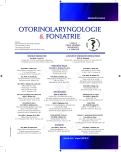-
Medical journals
- Career
Revision Septorhinoplasties
Authors: P. Doležal
Authors‘ workplace: Katedra otorinolaryngológie, Lekárska fakulta Slovenskej zdravotníckej univerzity v Bratislave, ORL oddelenie Nemocnice sv. Michala, Bratislava, primár doc. MUDr. P. Doležal, CSc., mim. prof.
Published in: Otorinolaryngol Foniatr, 64, 2015, No. 3, pp. 146-152.
Category: Original Article
Overview
Introduction:
Reoperation of the nose belongs to the most complicated procedures in rhinosurgery. They are usually requested by dissatisfied patient after the first operation. Bad functional result is not uncommon, but patient tolerates even better impaired nasal ventilation than a bad appearance. He asks to correct what is visible - nasal deviation, bulbous tip, retraction of nasal ala, domal irregularity, polybeak deformation or their combination. Impaired ventilation is caused by narrow nasal valve, nasal septal perforation, less frequent „forgotten“ basal septal crest or synechia between the septum and turbinates.Methods:
revision septorhinoplasties create by estimation less than 10% of all corrective nasal operations in the big centers. They are indicated not only for esthetic. In planning secondary rhinoplasty it is most important to localize the deformity and to determine its cause correctly. Deformity of upper nasal third has to be corrected by thorough osteotomy, eventually with wedge resection. Middle third of nasal pyramid is corrected by speader graft and camouflage grafts supporting the nasal dorsum. The lower third deformities are corrected via open approach, by interdomal suture, augmentation of nasal cartilages by septal or auricular grafts. Some special cases as inverted „V“ nasal deformity or, cleft lip nose, need combination of mentioned techniques.Results:
Obtained good functional results can be hardly proved. Patients claim about better breathing is determining. Esthetic results are even more difficult to evaluate, because they depend on patients opinion and on surgeons contentedness as well. In our group of patients percentage of reoperations from esthetic reason does not go beyond 5%, what is comparable with the data from literature. However, it can never contain whole group of operated patients, because dissatisfied patient will seek different workplace of esthetic surgery.Conclusion:
Revision rhinoplasty should be indicated after getting some experiences with primary nasal operations. Almost in each case there is necessary to use cartilaginous, in lesser extend bony grafts. They are harvested from septal crest. If there is not enough material for augmentation, auricular cartilage can be used.Keywords:
reoperation of the nose, revision septorhinoplasty, polybeak deformity, inverted „V“ deformity, cleft lip nose
Sources
1. Kasperbauer, J. L., Kern, E. B.: Nasal valve physiology. Implications in nasal surgery. Otolaryngol. Clin. North Am., 20, 1987, č. 4, s. 699-719.
2. Kaufman, Y., Buchanan, E. P., Wolfswinkel, E. M., Weathers, W. M., Stal, S.: Cleft nasal deformity and Rhinoplasty. Semin Plast. Surg., 26, 2012, č. 4, s. 184-190.
Labels
Audiology Paediatric ENT ENT (Otorhinolaryngology)
Article was published inOtorhinolaryngology and Phoniatrics

2015 Issue 3-
All articles in this issue
- Revision Septorhinoplasties
- Hearing Screening of Newborns in the Regional Hospital Pardubice
- Sialoendoscopy in Diagnostics and Therapy of Submandibular Sialolithiasis
- Manifestation of IgG4 Associated Disease in the Head and Neck Region
- Phoniatric Care for Patients with Temporary or Permanent Vocal Cord Paralysis Following Operations on the Thyroid Gland
- Juvenile Angiofibroma of Nasopharynx
- Peritonsillar Abscess in a 15 Month Old Infant
- Otorhinolaryngology and Phoniatrics
- Journal archive
- Current issue
- Online only
- About the journal
Most read in this issue- Phoniatric Care for Patients with Temporary or Permanent Vocal Cord Paralysis Following Operations on the Thyroid Gland
- Sialoendoscopy in Diagnostics and Therapy of Submandibular Sialolithiasis
- Juvenile Angiofibroma of Nasopharynx
- Revision Septorhinoplasties
Login#ADS_BOTTOM_SCRIPTS#Forgotten passwordEnter the email address that you registered with. We will send you instructions on how to set a new password.
- Career

